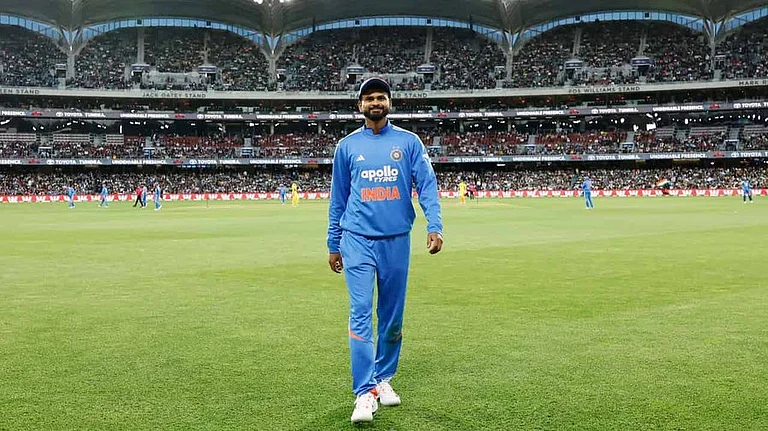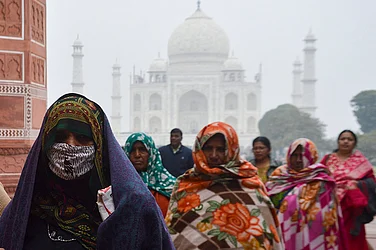“Who will now build the stairway to heaven?”
“People will,” my mother said. “In time.”
Ravan went up in flames that evening at Gandhi Maidan in Patna. This was many, many years ago. A stampede ensued. That was the only time I went to witness this violent act. Mother had told me once that Ravan was building a ladder that would make heaven accessible to everyone.
Was he a socialist? I asked. My mother said you could say so.
They say Ravan got tired midway and the project was shelved. But that was a fantastic idea. An idea that espoused egalitarianism and broke the myth of heaven as a place reserved only for the pious—a kind of gated colony. The haves and the have nots. The old, persistent divide.
What constituted dharma then? This, I asked my mother several times. She said beyond the ideas of sin, piety and moksha, there was this enduring idea of love and hope. She then cautioned me not to trust narratives, but to ask questions. Always.
ALSO READ: Who Is Ram? Defining The Enigma
“That’s why I am telling you these stories,” she said.
When I asked her who Ram is, she said he was Vishnu’s seventh avatar who came to earth to establish Utopia. He was a man who followed dharma, went to exile, and later, denounced his wife Sita, because he was the king and his people doubted her character after she had been abducted by Ravan.
“Did Ram miss Sita?” My mother said she thought he did.
“He shouldn’t have left her,” she said. That was a woman’s re-reading of the Ramayana. My mother’s.
This was in the 80s in Bihar, when stories were the only way to entertain ourselves. TV wasn’t so pervasive and the world wasn’t so small. In that great big world, there was space for many renditions of this mythological tale that seem to have become “history” now.

In order to understand how we interpret literature, including the epics, it is imperative to understand where we come from. Sita, my mother told me, was born in Bihar. She said she was born from the earth when a drop of Ravan’s sweat fell. There was an accompanying prophecy—Ravan’s end would come when he would desire Sita.
“Did Ravan know Sita was his daughter?” I asked. “He didn’t,” she said.
None of the girls I knew in school or college were named Sita. The name, my mother said, can bring that fate of abandonment to the bearer. Hence, there are no Sitas. But in Bihar’s Sitamarhi, there is a temple dedicated to Sita, perhaps the only one anywhere. That’s how we preserve the memory of a mythological character. Bihar has never let go of Sita even in the face of the Ram campaign. My mother still writes Jai SiyaRam in a notebook. In the temple in the neighbourhood, women congregate and sing bhajans and prefix Sita before Ram. Ram’s abandonment of Sita is a story we never forgot. Her sacrifice was bigger than any. That’s how we enter the Ramayana. Through Sita.
She said there are many stories and points of entry. Like in the Mahabharata. It could be the story of Karan, Draupadi or Shikhandi. “I’m telling you the possibilities I know of,” she said.
My Ramayana is then a composite of many stories told to me by men and women around me. It was a beautiful story. Like magic realism. Ravan had an aeroplane too. He could even order the moon to change its position. Ram touched a stone and it became a woman called Ahalya.
But all this was challenged by the reductive reading and broadcasting of a TV serial called Ramayan in the late 80s that reiterated a single narrative that limited the scope of any other interpretation. That was the time when mythology entered the political sphere and Ayodhya became the geographical node for the preservation of “nation” and “culture”. That’s how “othering” became a norm. Not that it wasn’t there before all this, but it gained momentum and eventually, got State sanction. The Hindu right wing utilised the reverential power of the epic, reduced and appropriated. The question is, how are we asked to read it and interpret it?
When I asked my mother, she said nobody reads. Neither the various Ramayanas, nor the Constitution or anything else. You have your own Ramayana, she said.
ALSO READ: Lesson On Environment From Ramayan
Nostalgia is power. The TV serial showed us a grand court in Ayodhya, a way to become the ideal man, a way to conquer with the ashwamedha horse let loose, a way to sacrifice everything to protect dharma, to even build a bridge so that a kingdom could be destroyed. They showed us the promise of the past and we bought the idea. We paid a cost. We lost our Ram somewhere in the frenzied reimagining of his character. I remember the calendars back then that showed him with his palm facing us, as if he was blessing us, unlike the weaponised version that’s so omnipresent now.
This was our most-loved story. The story of good over evil. Like a Dickensian plot. Like a morality play. The truth, my mother said, is never absolute. Ram is a tragic hero. Ravan a rebel, Sita a feminist, and so on.
All this and Ram came to us packaged in a 78-episode TV series telecast on Sunday mornings from January 25, 1987, to July 31, 1988, on the national broadcaster. Directed by Ramanand Sagar, it appeared around a time the country was witnessing a resurgence of Hindu nationalism. Ramayana instantly became an important focus of devotion for millions. I remember the old Bush TV set we had on which we watched the serial on Sundays and neighbours came to watch Lord Rama’s good deeds with folded hands. They would have taken a shower before and even offered flowers to the TV set.
My mother would later subtly embark on a course correction. She would say Ravan didn’t touch Sita. He waited for her consent. He had been angered because his sister Surpanakha’s nose, ears and breasts had been cut by Lakshman, because she had wanted either him or Ram to marry her. That was a case of disproportionate punishment, I said.
The way Sagar portrayed Surpanakha, where the actor had been padded to look big and had black paint all over her face with protruding teeth to give us a version of asurs—demons who knew no morals—differed from my mother’s rendition. She said Surpanakha was very beautiful and a widow.
“Are widows supposed not to remarry?” I asked.
Patriarchy is our inheritance. Like the epics. In school, we were beginning to read about reform movements like widow remarriage. The world order was changing. “Morality, too, is a question of time,” my favourite writer Marquez had once said.
That’s how we formed our versions of Ramayana. In our eras. In our contexts. There are many Ramayanas out there. Of scholars, poets, saints and those that belong to us. They say ideas aren’t copyrighted. Ramayana is also an idea.
To me, the melancholy of Surpanakha was also the story of Ramayana. She opposed the prescribed ways of life for women. She wanted revenge because she had been punished. Her desire to remarry hadn’t been so outrageous after all. Ramayana, the TV serial, presented an idea that the Hindu world was menaced by demons.
The Babri Masjid, on the site of the alleged birthplace of Ram in Ayodhya, was demolished by Hindu nationalists on December 6, 1992. The resulting riots left thousands dead.
That year, I encountered my first curfew. That year, I saw fear first-hand. That year, I saw how easily we alienated others. I remember that from the loudspeakers, the names of gods blared through the days and nights. Jai Sri Ram instead of Jai SiyaRam that we used to say. Fire, smoke and a lot of police.
In 1990, L.K. Advani had started his Rath Yatra in Somnath, Gujarat, and planned to end it in Ayodhya by laying a foundation stone for the construction of a Ram temple at the Babri Masjid site. On October 23, the Rath, an AC bus, entered Bihar despite warnings from the then CM Lalu Prasad Yadav, who had been sworn in just seven months earlier. The slogan had been “Kasam Ram ki khatein hain, Mandir wahin banayenge.” Lalu’s argument was that the Rath Yatra would incite riots.
In the wee hours of October 24, 1990, Advani was detained in Samastipur by Lalu’s government. The 11-month-old National Front government, led by V.P. Singh, collapsed after BJP withdrew support. Many things happened in the aftermath.
But who is Ram? That, we forgot to ask ourselves. We took the version of Ram in the serial. The appropriation began with the previous Congress government broadcasting the serial, when the Muslim Women’s bill was being drawn up after the Shah Bano case, and with the opening of the Babri Masjid in 1986. The BJP profited from what the Congress had started.
I remember the visuals of the kar sevaks dressed like Ram, Lakshman and Hanuman in the TV serial. The Rath was modelled after what was shown in it. The serial was telecast again during the Covid-19 lockdown. Millions again watched it. There is an insistence on that Ramayan.
We live in an era of Hindu awakening. It doesn’t take time to transform from devotional to political as we have witnessed with the serial—the first major departure from the secular consensus. Is this Ram Rajya? This, I asked my mother. “There’s a lot of inflation and other bad news on TV,” she said.
I am retelling a story from childhood in the hope that it might alter the present. I am being ambitious. They say don’t take the name of god in vain. But I grew up with Ram. I don’t fear my god.
I remember I had wanted Marni, her mother, our neighbourhood tailor Idhries miyan and his children to go to heaven. They were poor and never had enough to eat. Heaven would have food at least. Many years later, Idhries miyan killed himself by laying down on rail tracks. Marni worked at our house. They were Dalits. There would be no stairway to heaven. There is no heaven. Or hell.
I finally found my answers when I found myself in a remote village of the Asur tribe in Jharkhand recently.
Them and us. Us over them. All this and more. Gods and demons. Aryans and Dravidians. Men and women. Pitched against each other in eternal battles. Is there any redemption?
The tribals gave me an answer. “There’s no heaven or hell. We don’t believe in a better place than earth after death. We live with our dead,” Jacinta Kerketta, another tribal writer, said.
My Ramayana is a story of many people who make certain choices. The story is of love and loss and a dream called Utopia, abandoned when Ram took samadhi in River Sarayu. Perfection is always an illusion. To achieve it and sustain it is an endless saga of wars. We don’t need no more wars. My Ramayana is a story of struggle against society’s imposed morality, of kings and queens who are products of their circumstances and choices. It is my story. It is our story.
The issue is a compilation of some of those stories and some of those characters and an attempt to not reduce them to a singular narrative. That’s always dangerous.

























